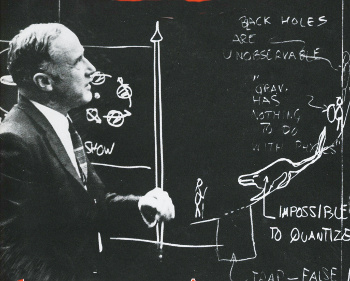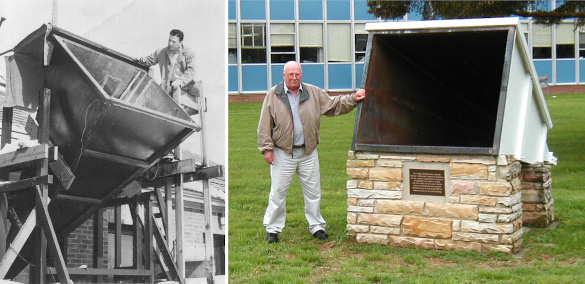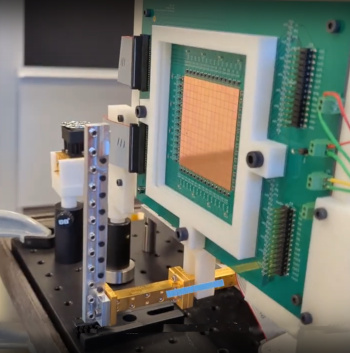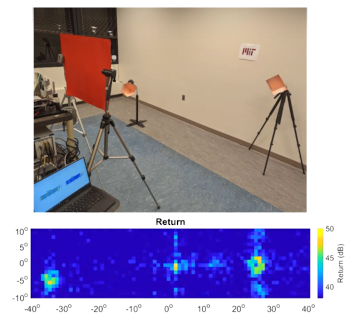Terahertz Imaging
April 11, 2022
Scientists are often released from
laboratory confinement for an occasional
field trip, or to attend some of the many
annual and topical conferences hosted by
scientific societies. On such outings, I've had occasion to meet some pivotal figures in the
history of science. There was the half-minute trip in a
hotel elevator in which the sole
occupants,
Nobel Physics Laureate,
Phil Anderson (1923-2020), and I exchanged
pleasantries. Naturally, I recognized him, but to him I was just another conference
attendee. I was also excited to meet
John Wheeler (1911-2008) at another conference at which he
autographed one of his
books for me.[1] I wrote about Wheeler in an
earlier article (John Archibald Wheeler. March 25, 2019).

A physicist's purposeful pose.
The culmination of John Archibald Wheeler's adventures in relativity is the 1973 publication of the book, Gravitation with coauthors Charles Misner (b. 1932) and Kip Thorne (b. 1940).[1]
Wheeler also published an autobiography entitled, "Geons, Black Holes, and Quantum Foam: A Life in Physics," in 1998.[2]
(Portion of Geons dust jacket, scan of my copy. Click for larger image.)
In the 1990s I was a member of a
research team doing a project that involved
microwave radiometry. We had decided on the
purchase of a rather
expensive instrument for this; and, as
due diligence, we went on a field trip to the
manufacturer. It was there that we met
Harold "Doc" Ewen (1922-2015), a physicist best known for his 1951 discovery of the the
21-cm line of neutral hydrogen while a
graduate student at
Harvard University under
Edward Purcell (1912-1997).[3] Purcell soon shared the 1952
Nobel Prize for Physics for the 1946 discovery of
nuclear magnetic resonance in
liquids and in
solids.
This
spectral line, also called the
H I line, is associated with an
electron spin-flip transition in which the
spin of the
electron of the
hydrogen atom flips from
parallel alignment with the proton spin to an
inverse alignment. In this process, it
emits electromagnetic radiation at the microwave
frequency of 1.42
GHz. This transition was predicted by
Hendrik van de Hulst (1918-2000) in 1944, and the detection by Ewen and Purcell led to a
mapping of the
spiral structure of the
Milky Way, a significant
milestone in
radio astronomy

Harold "Doc" Ewen in 1951 with the microwave horn antenna he built (left), and posing with that same antenna on the grounds of the National Radio Astronomy Observatory, Green Bank, West Virginia, on May 22, 2001 (right). Ewen was a graduate student at Harvard University under Edward Purcell. Purcell's expertise in microwaves arose from his work on radar at the MIT Radiation Laboratory during World War II. Ewen's horn antenna was just outside a fourth floor window of the Lyman Laboratory of Physics at Harvard, and it connected to a receiver and chart recorder through a waveguide. The funding for the entire project was just $500 ($5,500 in today's money) with Ewen doing the work on weekends.[4] (From the right photograph, it appears that Ewen and I owned very similar Members Only jackets at the time. Left image, and right image, from the National Radio Astronomy Observatory Website.[4] Click for larger image.)
During our team visit, Ewen demonstrated an
instrument he was perfecting. It was a
radar imager operating at nearly 100 GHz, which is about a hundred times higher in frequency than the 21 cm hydrogen line. The imager was crude, since at that time the only way to scan was
mechanically, but it did demonstrate the important fact that such
radiation will penetrate thin
walls and image a
human within a
building.
A step above these frequencies is
terahertz (THz) radiation, 10
12 hertz, about a thousand times higher in frequency than the 21 cm hydrogen line. However, by the strange way that the
International Telecommunication Union designates
terahertz frequency bands, the
terahertz frequency band is the frequency range from 0.3 THz to 3 THz, and a
wavelength range of 1
mm to 100
μm.
Our ability to
generate and
detect THz radiation has improved in the thirty years since that time, and the utility of such radiation in applications including those for
security and
communications has inspired continued research. A team of
electrical engineers at
MIT's Microsystems Technology Laboratories and
Intel Corporation have created a device that
electronically steers and focuses a
beam of terahertz electromagnetic radiation.[5-6] Their
array of 98 x 98 elements, which they've named a
reflectarray operates at 265 GHz. Its 9,604 elements is about the size of a
credit card (see figure).[5]

The terahertz radar on a test stand.
fabricating the entire array of 98 x 98 elements would be too difficult, so the "reflectarray" is built from 14 x 14 chips that are interconnected with gold wires.[5]
The feed waveguide is shown in gold at the bottom, and it's coupled to a feed antenna at the central axis of the array.
(Still image from a YouTube video by MIT's Han Group.[6] Click for larger image.)
This research, led by MIT
associate professor Ruonan Han, was presented at the
2022 International Solid-State Circuits Conference, February 20-28, which was an
online-only conference this year. Coauthors include
Nathan Monroe and
Xibi Chen of MIT, and Georgios Dogiamis, Robert Stingel, and Preston Myers of Intel Corporation.[6]
Intel corporation fabricated the chips using the high-frequency
transistors of the Intel
"16" silicon process.[5] As Han explained,
"Before this research, people really did not combine terahertz technologies and semiconductor chip technologies to realize this ultra-sharp and electronically-controlled beam forming... By leveraging the integrated circuit technology, now we can enable some in-element memory and digital behaviors, which is definitely something that didn't exist in the past."[5]
The device works using traditional
phased-array antenna beamforming. Each array element delays
reflection of the terahertz feed to achieve steering of the reflected beam.[5] Integrating the antenna array directly onto a device with memory allowed the array to store a
library of different
phases, and this increased scanning speed.[5] The resulting terahertz device images in a way similar to a
LiDAR (light detection and ranging) device; but, unlike LiDAR, it can image in
rain,
fog, or
snow at high resolution.[5] The radar beam is just a
degree wide, the scan is in increments of one degree, and it images in
real-time.[5]
Possible applications include imagers for
autonomous vehicles and
autonomous drones, the later application taking advantage of the potential low
weight of the imager and the fact that it has no
moving parts.[5] It can operate as a non-intrusive and rapid
body scanner in security applications.[5] This research was funded by Intel Corporation and the
MIT Center of Integrated Circuits and Systems.[5]

Performance of the terahertz (THz) radar imager.
In this case, the imaging is through a poster board that's opaque to light, but not the THz radiation.
Retroreflectors are used as targets, which enhances the radar return signal.
(Still image from a YouTube video by MIT's Han Group.[6] Click for larger image.)
References:
- John Archibald Wheeler, Kip S. Thorne, and Charles W. Misner, Gravitation (2017 Revised Edition), Princeton University Press, 1279 pp. + xxvi, ISBN 0-7167-0344-0 (via Amazon).
- John Archibald Wheeler, Geons, Black Holes, and Quantum Foam: A Life in Physics, W. W. Norton & Company, Revised Paperback edition (February 17, 2000), ISBN: 978-0393319910, 416 pp. (via Amazon).
- H. I. Ewen and E. M. Purcell, "Observation of a Line in the Galactic Radio Spectrum: Radiation from Galactic Hydrogen at 1,420 Mc./sec," Nature, vol 168, no. 4270 (September 1, 1951), p. 356, https://doi.org/10.1038/168356a0.
- The Ewen-Purcell Horn at Green Bank, National Radio Astronomy Observatory Website.
- Adam Zewe, "Credit card-sized device focuses terahertz energy to generate high-resolution images," MIT Press Release, February 18, 2022. Also available here
- ISSCC 2022 Demo: Terahertz Imaging Radar via CMOS Reflectarray, YouTube Video by Nathan Monroe, February 3, 2022.
Linked Keywords: Scientist; laboratory; confinement; field trip; annual and topical conferences; learned society; scientific society; history of science; conference hotel; elevator; occupant; Nobel Physics Laureate; Phil Anderson (1923-2020); pleasantry; attendance; attendee; John Archibald Wheeler (1911-2008); autograph; book; Geons; physicist; pose; relativity; publishing; publication; Gravitation (book); author; coauthor; Charles Misner (b. 1932); Kip Thorne (b. 1940); autobiography; dust jacket; research; microwave; radiometry; purchasing; purchase; cost; expensive; scientific instrument; due diligence; manufacturing; manufacturer; Harold "Doc" Ewen (1922-2015); hydrogen line; 21-cm line of neutral hydrogen; postgraduate education; graduate student; Harvard University; Edward Purcell (1912-1997); Nobel Prize in Physics; nuclear magnetic resonance; liquid; solid; spectral line; H I line; hyperfine structure; electron spin-flip transition; spin (physics); electron; hydrogen atom; parallel (geometry); parallel alignment; inverse alignment; emission spectrum; emit; electromagnetic radiation; frequency; hertz; GHz; Hendrik van de Hulst (1918-2000); map; mapping; spiral galaxy; spiral structure; Milky Way; milestone; radio astronomy; horn antenna; National Radio Astronomy Observatory; Green Bank, West Virginia; expert; expertise; radar; MIT Radiation Laboratory; World War II; window; Lyman Laboratory of Physics; receiver (radio); chart recorder; waveguide; funding of science; inflation; today's money; Members Only (fashion brand); jacket; electronic imager; machine (mechanical); mechanically; wall; human; building; terahertz (THz) radiation; International Telecommunication Union; terahertz frequency band; wavelength; millimeter; micrometer; transmitter; generate; detector (radio); detect; security; communication; electrical engineering; electrical engineer; Massachusetts Institute of Technology; MIT; Microsystems Technology Laboratories; Intel Corporation; phased array; electronically steer and focus; beam; antenna array; credit card; semiconductor device fabrication; fabricate; integrated circuit; chip; electrical connection; interconnection; gold; wire; feed waveguide; antenna feed; feed antenna; associate professor; Ruonan Han; 2022 International Solid-State Circuits Conference, February 20-28; internet; online; Nathan Monroe; Xibi Chen; transistor; 14 nm process; "16" silicon process; computer memory; digital; phased-array antenna beamforming; reflection (physics); library (computing); phase (waves); LiDAR (light detection and ranging); rain; fog; snow; degree (angle); real-time data; self-driving car; autonomous vehicle; unmanned aerial vehicle; autonomous drone; weight; moving parts; body scanner; MIT Center of Integrated Circuits and Systems; display board; poster board; opacity (optics); opaque to light; retroreflector; bullseye (target); target; echo; return signal.